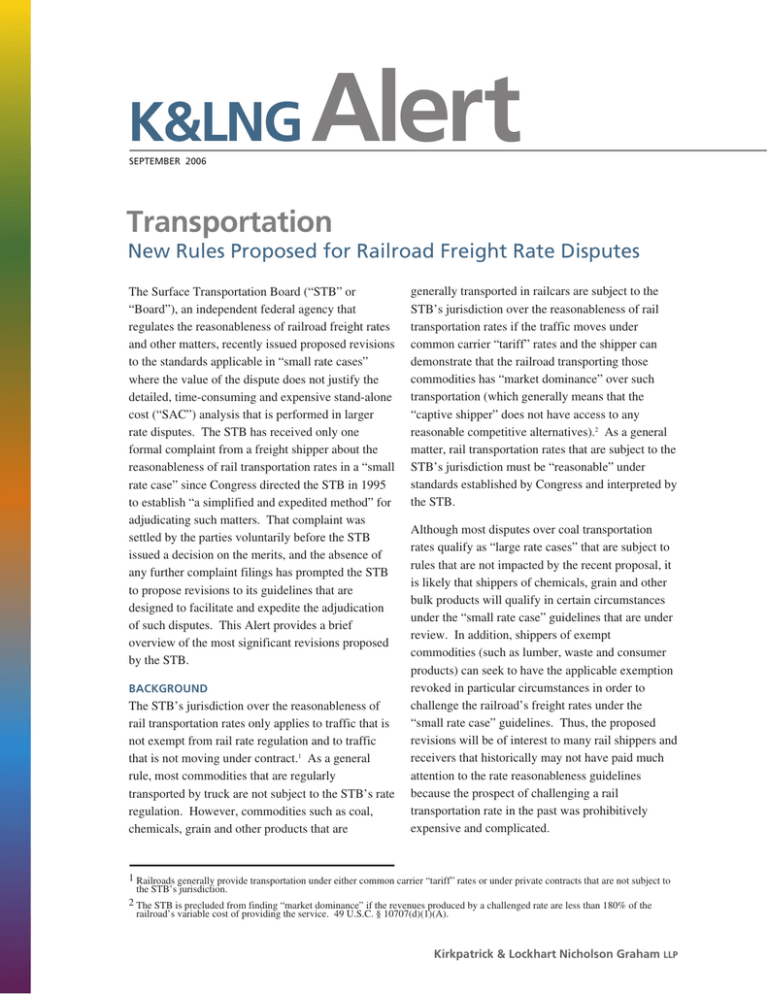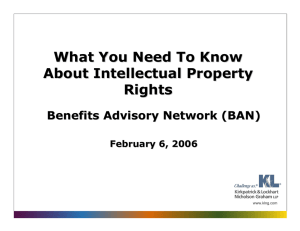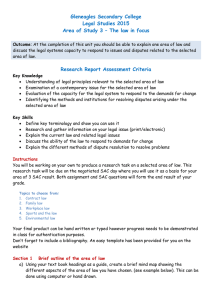
K&LNG
SEPTEMBER 2006
Alert
Transportation
New Rules Proposed for Railroad Freight Rate Disputes
The Surface Transportation Board (“STB” or
“Board”), an independent federal agency that
regulates the reasonableness of railroad freight rates
and other matters, recently issued proposed revisions
to the standards applicable in “small rate cases”
where the value of the dispute does not justify the
detailed, time-consuming and expensive stand-alone
cost (“SAC”) analysis that is performed in larger
rate disputes. The STB has received only one
formal complaint from a freight shipper about the
reasonableness of rail transportation rates in a “small
rate case” since Congress directed the STB in 1995
to establish “a simplified and expedited method” for
adjudicating such matters. That complaint was
settled by the parties voluntarily before the STB
issued a decision on the merits, and the absence of
any further complaint filings has prompted the STB
to propose revisions to its guidelines that are
designed to facilitate and expedite the adjudication
of such disputes. This Alert provides a brief
overview of the most significant revisions proposed
by the STB.
BACKGROUND
The STB’s jurisdiction over the reasonableness of
rail transportation rates only applies to traffic that is
not exempt from rail rate regulation and to traffic
that is not moving under contract.1 As a general
rule, most commodities that are regularly
transported by truck are not subject to the STB’s rate
regulation. However, commodities such as coal,
chemicals, grain and other products that are
generally transported in railcars are subject to the
STB’s jurisdiction over the reasonableness of rail
transportation rates if the traffic moves under
common carrier “tariff” rates and the shipper can
demonstrate that the railroad transporting those
commodities has “market dominance” over such
transportation (which generally means that the
“captive shipper” does not have access to any
reasonable competitive alternatives).2 As a general
matter, rail transportation rates that are subject to the
STB’s jurisdiction must be “reasonable” under
standards established by Congress and interpreted by
the STB.
Although most disputes over coal transportation
rates qualify as “large rate cases” that are subject to
rules that are not impacted by the recent proposal, it
is likely that shippers of chemicals, grain and other
bulk products will qualify in certain circumstances
under the “small rate case” guidelines that are under
review. In addition, shippers of exempt
commodities (such as lumber, waste and consumer
products) can seek to have the applicable exemption
revoked in particular circumstances in order to
challenge the railroad’s freight rates under the
“small rate case” guidelines. Thus, the proposed
revisions will be of interest to many rail shippers and
receivers that historically may not have paid much
attention to the rate reasonableness guidelines
because the prospect of challenging a rail
transportation rate in the past was prohibitively
expensive and complicated.
1 Railroads generally provide transportation under either common carrier “tariff” rates or under private contracts that are not subject to
the STB’s jurisdiction.
2 The STB is precluded from finding “market dominance” if the revenues produced by a challenged rate are less than 180% of the
railroad’s variable cost of providing the service. 49 U.S.C. § 10707(d)(1)(A).
Kirkpatrick & Lockhart Nicholson Graham LLP
The proposed revisions to the “small rate case”
guidelines are designed to achieve the dual objective
of providing captive shippers with meaningful
access to regulatory relief for rail transportation
rates that are unreasonable, while recognizing the
need for railroads to earn “adequate revenues” and a
reasonable return on their investment through
differential pricing and other methods.3 The STB’s
general standard for judging the reasonableness of
freight rates adopts a set of pricing principles known
as Constrained Market Pricing (“CMP”), which
contain various constraints on the extent to which
railroads may charge differentially higher rates on
captive traffic. The constraint most frequently used
to challenge rail rates is the stand-alone cost
(“SAC”) constraint, which protects a captive shipper
from bearing costs of inefficiencies or from crosssubsidizing facilities or services from which it
derives no benefit.
relation to three benchmark figures: (1) the Revenue
Shortfall Allocation Method (“RSAM”), which
measures the average markup that the railroad would
need to charge all of its “potentially captive” traffic
in order to earn adequate revenues, (2) the “R/VC >
180” method, which measures the average markup
applied by the railroad on its potentially captive
traffic, and (3) the “R/VC Comp” method, which
compares the markup being paid by the challenged
traffic to the average markup assessed on other
potentially captive traffic involving the same or a
similar commodity moving similar distances. These
figures are calculated using industry data published
by the Board, traffic data from waybill samples, and
costing data. These benchmarks and other
procedural and evidentiary standards were
established to expedite and facilitate the number of
challenges in “small rate cases” by providing an
alternative to the full SAC cost presentation.
A SAC challenge seeks to determine the competitive
rate that would exist in a “contestable market” free
from entry barriers. This is accomplished by
modeling and forecasting the cost and revenue
requirements of a stand-alone railroad (“SARR”) to
determine a simulated competitive rate against
which the challenged rate is judged. Under the SAC
constraint, the rate at issue cannot be higher than
that which the SARR would need to charge in order
to fully cover its costs and earn a reasonable return
on its investment. The Board has determined that
the SAC analysis is the most accurate procedure
available for determining the reasonableness of rail
rates subject to its jurisdiction. However, the cost
and expense involved in bringing a SAC challenge
are enormous – the Board estimates that a typical
SAC challenge costs more than $3.5 million and
takes several years to pursue. Thus, Congress
directed the Board to come up with simplified
guidelines in those situations where a full SAC cost
presentation is too costly given the value of the case.
However, given the paucity of rate challenges
initiated since the Simplified Guidelines were issued
in 1996, and the uncertainty surrounding how the
Board would determine what type of shipper would
be eligible to use the “small rate case” procedure,
the Board has proposed additional revisions to its
Simplified Guidelines. As explained further below,
the Board has proposed using a simplified version of
the SAC procedure in a new category of “mediumsize rate disputes,” has proposed modifications and
refinements to the “Three-Benchmark Method”
applicable to small rate disputes, and has proposed
eligibility presumptions based on the maximum
value of the case to distinguish between large,
medium-size and small rate disputes. Each of these
proposed changes are discussed further below.
PROPOSED REVISIONS TO SIMPLIFIED
GUIDELINES
Under the Simplified Guidelines established by the
Board in 1996, the reasonableness of challenged
rates in “small rate cases” is to be determined in
PROPOSED STANDARDS FOR MEDIUM-SIZE RAIL
RATE DISPUTES
The Board has proposed using a simplified SAC
method in “medium-size” disputes. Under this
method, the inquiry would be limited to whether the
captive shipper is being forced to cross-subsidize
other parts of the railroad’s rail network. It would
not attempt to identify inefficiencies in the current
rail operation, which turns the full SAC presentation
into an intricate and expensive undertaking.
3 49 U.S.C. § 10704(a)(2) defines “adequate revenues” as those that are sufficient – under honest, economical, and efficient
management – to cover operating expenses, support prudent capital outlays, repay a reasonable debt level, raise needed equity capital,
and otherwise attract and retain capital in amounts adequate to provide a sound rail transportation system.
2
Kirkpatrick & Lockhart Nicholson Graham
LLP
|
SEPTEMBER 2006
The Board believes that this method, although less
precise than a full application of the CMP principles,
would create a simplified and expedited method for
determining whether a railroad is exercising its
market power to charge more than necessary to earn
adequate revenues.
To minimize the costs of a simplified SAC
proceeding, the Board has proposed various
simplifying assumptions and standardization
measures. For example, the total operating and
equipment expenses of the SARR would be
estimated using the Uniform Rail Costing System
(“URCS”) to avoid the disputes over operating plans
and network configurations that typically consume
much of a full SAC proceeding. In addition, no
rerouting of non-challenged traffic would be
permitted over the one-year test period and no
movement-specific adjustments to variable costs
would be permitted. Moreover, final future rate
prescriptions would not be calculated but the parties
would be instructed to apply the maximum lawful
rate for five years (inclusive of any reparations
period). The Board also has proposed a tight
procedural schedule and streamlined discovery rules
to accomplish its goal of expediting and facilitating
such medium-size disputes. Under the proposed
procedural schedule, eligibility for the medium-size
rate dispute method would be determined within 50
days and a final decision on the merits would be
issued within 1-and-1/2 years of the filing of the
complaint.
PROPOSED REVISIONS TO SMALL RATE CASE
METHODOLOGY
The Board has proposed to retain the “ThreeBenchmark” method to small rate disputes with
certain refinements to reduce the uncertainties of the
existing method. For example, the Board seeks to
use a final-offer procedure to select the comparison
group most similar to the challenged movement in
the R/VC-Comp benchmark. In addition, the Board
has proposed revisions to its methodology for
calculating the RSAM benchmark (using an
unadjusted figure) and the R/VC > 180 benchmark
(which would be renamed R/VC Total). Similar to
the method proposed for medium-size disputes, the
Board seeks to use only adjusted variable costs and
has proposed an extremely limited discovery process
3
(ten interrogatories, ten document requests and one
deposition per party). Under the Board’s proposed
procedural schedule, eligibility for the small rate
dispute method would be determined within 50 days
and a final decision on the merits would be issued
within one year of the filing of the complaint.
Finally, the Board also would limit the duration of
rate relief to five years under the small rate case
method.
ELIGIBILITY CRITERIA FOR DIFFERENT METHODS
Under the Board’s proposal, there would be three
different methods for determining the reasonableness
of rates – large disputes would require the full SAC
analysis, medium-size disputes could use full SAC
analysis or the simplified SAC analysis, and small
disputes could use any of the three methods (full
SAC, simplified SAC or Three-Benchmark). The
eligibility criteria would be based on the Maximum
Value of the Case (“MVC”) – in other words, the
maximum rate relief the shipper could attain over
five years if the challenged rates were reduced to the
jurisdictional floor (i.e., the level at which the
revenue to variable cost ratio equals 180%). To
compute the MVC, the Board would multiply the
difference between the challenged rate and the rate
floor by the annual volume of the traffic at issue
based on historical patterns or shipper assertions
with respect to anticipated future traffic. In effect,
the MVC would equal the net present value of the
maximum relief the shipper could obtain at the time
of filing the complaint.
If the MVC exceeds $3.5 million (the Board’s
estimate of how much it costs to present a full SAC
analysis), the Board would presume that the
complaint could present a full SAC analysis. If the
MVC is between $200,000 and $3.5 million, the
Board would presume that either the full SAC or
simplified SAC approach could be used. Finally, if
the MVC is less than $200,000, the complainant
could use the Three-Benchmark method. The
shipper could rebut these presumptions based on the
likely actual (as opposed to maximum) value of the
case, thereby giving it the flexibility to use different
methods if warranted in a particular situation.
CONCLUSION
The comment period on the Board’s proposed rules
is scheduled to close in December 2006. Therefore,
Kirkpatrick & Lockhart Nicholson Graham
LLP
|
SEPTEMBER 2006
the Board most likely will not issue final rules until
the Spring of 2007. Despite the vigorous debates
that are likely to arise during the comment period,
the Board is likely to adopt many of its proposed
revisions in order to fulfill its mandate to create an
expedited and less burdensome avenue for relief in
rate cases where a full SAC presentation is too
costly. Chemical companies, heavy industries, grain
producers and other users of rail service should
follow the development of these rules carefully.
Likewise, many railroads that have not been
involved in rate reasonableness challenges
historically (particularly short-line railroads) should
track the development of these rules and their
potential impact on their commercial relationships
with captive shippers.
Edward J. Fishman
efishman@klng.com
202.778.9456
If you have questions about this topic or would like more information on Kirkpatrick & Lockhart Nicholson Graham LLP, please contact
one of our lawyers listed below:
BOSTON
Joel D. Almquist
Jeffrey S. King
PITTSBURGH
617.261.3104
617.261.3179
jalmquist@klng.com
jking@klng.com
John P. Englert
412.355.8331
Theodore A. McConnell 412.355.6566
Stephen M. Olson
412.355.6496
jenglert@klng.com
tmcconnell@klng.com
solson@klng.com
James P. Melia
717.231.5842
jmelia@klng.com
WASHINGTON
Carleton O. Strouss
717.231.4503
cstrouss@klng.com
Kevin M. Sheys
202.778.9290
ksheys@klng.com
Edward J. Fishman
202.778.9456
efishman@klng.com
HARRISBURG
www.klng.com
BOSTON • DALLAS • HARRISBURG • LONDON • LOS ANGELES • MIAMI • NEWARK • NEW YORK • PALO ALTO • PITTSBURGH • SAN FRANCISCO • WASHINGTON
Kirkpatrick & Lockhart Nicholson Graham LLP (K&LNG) has approximately 1,000 lawyers and represents entrepreneurs, growth and middle market companies,
capital markets participants, and leading FORTUNE 100 and FTSE 100 global corporations nationally and internationally.
K&LNG is a combination of two limited liability partnerships, each named Kirkpatrick & Lockhart Nicholson Graham LLP, one qualified in Delaware, U.S.A. and
practicing from offices in Boston, Dallas, Harrisburg, Los Angeles, Miami, Newark, New York, Palo Alto, Pittsburgh, San Francisco and Washington and one
incorporated in England practicing from the London office.
This publication/newsletter is for informational purposes and does not contain or convey legal advice. The information herein should not be used or relied
upon in regard to any particular facts or circumstances without first consulting a lawyer.
Data Protection Act 1988—We may contact you from time to time with information on Kirkpatrick & Lockhart Nicholson Graham LLP seminars and with our
regular newsletters, which may be of interest to you. We will not provide your details to any third parties. Please e-mail london@klng.com if you would prefer
not to receive this information.
© 2006 KIRKPATRICK & LOCKHART NICHOLSON GRAHAM LLP. ALL RIGHTS RESERVED.
Kirkpatrick & Lockhart Nicholson Graham
LLP
|
SEPTEMBER 2006



